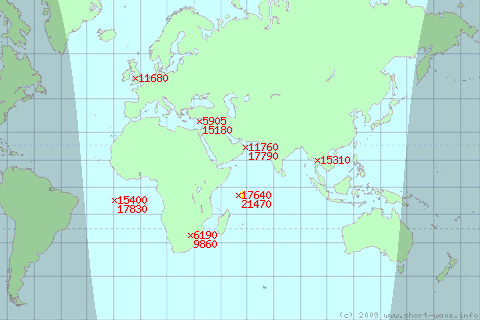 Apparently, mobile phone operators are beginning to run out of capacity on their networks due to all the data traffic that is being generated by smart-phones and people using broadband dongles in their laptops. Of course, whether or not this is true or not today or whether it is just an excuse for poor service quality, there will almost certainly come a time in the relatively near future when it the squeeze on spectrum becomes reality.
Apparently, mobile phone operators are beginning to run out of capacity on their networks due to all the data traffic that is being generated by smart-phones and people using broadband dongles in their laptops. Of course, whether or not this is true or not today or whether it is just an excuse for poor service quality, there will almost certainly come a time in the relatively near future when it the squeeze on spectrum becomes reality.A typical mobile operator in an average European country will currently have access to something like 100 MHz of radio spectrum - 50 MHz for the uplink from phones to base stations and another 50 MHz in the opposite direction - more commonly written 2 x 50 MHz. This will be in usually two (or more) of the commonly available mobile bands, such as:
- 900 MHz (actually 880 - 915 and 925 - 960 MHz)
- 1800 MHz (1710 - 1785 and 1805 - 1880 MHz)
- 2100 MHz (1920 - 1980 and 2110 - 2170 MHz)
- 800 MHz (791 - 821 and 832 - 862 MHz) - the 'digital dividend'
- 2600 MHz (2500 - 2570 and 2620 - 2690 MHz) - note that the gap between 2570 and 2620 MHz is also available
So what's the problem? Some observers (eg Cisco) claim that mobile data traffic is doubling roughly every year, so this 60% increase in capacity will amount to about 8 months of traffic growth, then the problem starts all over again. New technology will deal with some growth. Newer mobile technologies from HSPA+ to LTE and LTE-Advanced may offer a doubling in capacity over current 3G (UMTS) networks for each unit of spectrum. Another year dealt with, and only at the cost of changing over all of the network equipment and handsets!
On this front, it is perhaps no surprise that UK mobile operator O2 recently announced plans to offer free WiFi for all. Why is this no surprise? If the traffic from smartphones and laptops can be offloaded from the mobile network to WiFi hotspots, this will ease the burden on the mobile network. But this is a relatively short-term fix too. In the long term, the only way that mobile operators will be able to deal with the growth in data traffic is to get access to more spectrum. But where will this spectrum come from?
It has long been recognised that to offer a sensible (in terms of cost, coverage and capacity) mobile network, frequencies in the range 300 to 3000 MHz are best. Go any higher and things such as Doppler shift and cell handover become real problems. Go any lower and antennas become too large and unwieldy. The problem is that the remaining frequencies in this range are already being used. In general terms:
- 300 to 430 MHz is military territory
- 430 to 440 MHz is radio amateur land
- 440 to 470 MHz is full with PMR systems
- 470 to 790 MHz has UHF television broadcasters in it
- 790 to 862 MHz is already mobile
- 862 to 880 MHz houses all manner of low power devices
- 880 to 960 MHz is already mobile
- 960 to 1350 MHz is where aircraft radars and some radio amateurs live
- 1350 to 1710 MHz is for satellites (including GPS and weather satellites), DAB broadcasting and more tanks, planes and guns
- 1710 to 1980 MHz is already mobile
- 1980 to 2110 MHz is partly mobile and partly full of military folk
- 2110 to 2170 MHz is already mobile
- 2170 to 2400 MHz is mostly military
- 2400 to 2500 MHz is WiFi and bluetooth land
- 2500 to 2690 MHz is already mobile
- 2690 to 2700 MHz is where radio astronomers hang out (mostly in cardigans)
- 2700 to 3100 MHz is aircraft and maritime radars
Clearly, anyone who moves out for the benefit of mobile services will either have to stop doing what they do (unlikely) or go and do it somewhere else (costly). For any international service (eg boats and planes) this cannot be done unilaterally and getting international agreement is probably too slow. What's more, radars and things such as that need a lot of spectrum due to the way they work and furthermore, removing them might cause planes to fall out of the sky, which would seriously disrupt tourism in many parts of Europe that aren't very close to where you live (though it might have a potential commercial upside for undertakers).
Wireless Waffle is therefore going to stick it's neck out and make a proposal as to who should lose the battle for this important part of the spectrum and that is ... the broadcasters!
On a completely different, but not unrelated tack, the amount of energy consumed by a terrestrial broadcasting networks is, well, large. Not 'a whole power station' large, but still pretty big. The amount of energy consumed by a satellite is tiny. In fact, once it's up in the sky, it's zero (they are solar powered). A terrestrial broadcast network also delivers much less capacity than a satellite. So broadcasting by satellite consumes much less power (and therefore has a much lower carbon footprint) and offers much greater capacity (for services such as 'The Cartoon Network' in HD). Let's therefore turn off UHF broadcasting and give the spectrum to mobile networks - the broadcasters can go to cable and satellite and can continue to use the VHF band if they really want to.
What would a world without UHF broadcasting look like. In somewhere such as the Netherlands where 90% or more of homes are on cable, not a lot different. It would mean that people's holiday homes might need a satellite dish but these are so cheap and plentiful it should be no big deal. In the UK where most homes still have a terrestrial UHF receiver you might think this would be a bigger deal, but over 50% of homes have either satellite or cable already and again, having to buy a dish is no biggie, so other than the temporary inconvenience of swapping set top boxes and putting a dish up (or getting connected to cable) nothing much would change.
If they so desired, public service broadcasters could continue terrestrial television broadcasting using the VHF band - by switching off those ancient and largely unlistened-to DAB transmitters. DAB could be replaced by DRM and Bob's your uncle - no loss of anything important, just a bit of shuffling around.
If all this sounds far fetched, watch this space. Or, perhaps more accurately, watch outer space!
1 comment
( 33885 views )
| permalink
| 



 ( 2.7 / 54272 )
( 2.7 / 54272 )




 ( 2.7 / 54272 )
( 2.7 / 54272 )
Thursday 12 March, 2009, 09:00 - Licensed
Posted by Administrator
Posted by Administrator
 Have you ever tuned into your local radio station and heard the travel news being read out from the 'eye in the sky' - a presenter checking out the traffic from an aircraft high over the area concerned? Have you ever stopped to think how that is done? Well Wireless Waffle is here to help explain it all.
Have you ever tuned into your local radio station and heard the travel news being read out from the 'eye in the sky' - a presenter checking out the traffic from an aircraft high over the area concerned? Have you ever stopped to think how that is done? Well Wireless Waffle is here to help explain it all.There is no denying that it would be very easy for any radio station to pretend to have a traffic plane or helicopter by playing sound effects in the background whilst the travel news was read out. However, there are some real benefits about doing it properly, not least it is possible to find out how the traffic is flowing as and when problems occur instead of waiting for listeners to phone in news (which can be unreliable) or for the local police or traffic department to let you know what's happening. But that doesn't mean that the aircraft in question can necessarily see all the problems in an area and in some cases, it is not possible to fly over certain areas due to airspace restrictions (for example, it would not make sense for a 'traffic plane' to be buzzing around a major airport, stopping commercial airliners from landing!)
What happens, therefore, is that there is someone on the ground who collates traffic information in the normal way (eg through listeners or the police) and then relays this information to the man in the aircraft. The plane (or chopper) can then visit some of the travel hotspots and see what is happening and if, along the way, they see other problems that haven't been reported, they can update the person on the ground. This means that, in general, travel news from an aircraft is more accurate and up-to-date than travel news from a regular travel studio.
From the technology perspective, there is lots of radio used (hence the Wireless Waffle interest). For starters, the pilot will be communicating with various air traffic controllers on the VHF aeronautical band (117.975 to 137.000 MHz).
 Next, there is a need for the person on the ground, including the presenter in the radio studio, to be able to communicate with the presenter in the aircraft - the 'uplink'. Typically this is done via a simple VHF or UHF PMR frequency (in the UK try listening around 141.000 to 141.500 MHz and 455.000 to 455.500 MHz). As well as passing travel news to the airborne presenter, this frequency is also often used as the 'cue', providing a live feed of the station on which the travel news is to be broadcast so that the airborne presented knows when to start reading the news.
Next, there is a need for the person on the ground, including the presenter in the radio studio, to be able to communicate with the presenter in the aircraft - the 'uplink'. Typically this is done via a simple VHF or UHF PMR frequency (in the UK try listening around 141.000 to 141.500 MHz and 455.000 to 455.500 MHz). As well as passing travel news to the airborne presenter, this frequency is also often used as the 'cue', providing a live feed of the station on which the travel news is to be broadcast so that the airborne presented knows when to start reading the news.Finally there is a the link from the airborne presenter to the ground - the 'downlink'. This is usually (but not always) a slightly higher quality link than the uplink as the audio is going to be broadcast. In the UK, these links are usually at UHF (try between 467.250 and 469.900 MHz). As they are transmitted from the aircraft, despite being low power, they can often be heard over a wide area.
If the aircraft is providing travel news for a wide area, more than one up and/or downlink might be used for the different areas, depending on whether or not frequencies which can be used over a wide area are available.
In some countries, the presenter uplink and downlink are also in the aeronautical VHF band (this is the case, for example, in Malta), and the frequencies use do vary significantly between countries. If you are in an area where the local radion station has a travel plane or helicopter, why not have a tune around and see what you can find and post a comment to let us all know.
Tuesday 17 February, 2009, 20:38 - Licensed
Posted by Administrator
My couple of previous posts concerning reception of BBC World Service English language programmes on short-wave in Europe led me to wondering whether there wasn't a more elegant solution to the problem of identifying which frequencies to tune to at any given time of the day.Posted by Administrator
As it happens, every 6 months, the majority of international broadcasters get together and sit down to negotiate and co-ordinate their HF frequency usage for the coming 6 months at a conference known as the High Frequency Co-ordination Conference. The resulting plans (know as the Winter and Summer seasons) are published on the web. So with a little ingenuity and a few spare hours, Wireless Waffle proudly presents:
* The 'find a frequency in a given language, for a particular broadcaster (or both) analysis tool' *
(catchy name isn't it?!)
It works like this: You can select broadcasts in a particular language, or by a particular broadcaster in which case you will be presented with a list of transmissions currently on-air (or on-air at a time you select) today for that broadcaster together with a map of the world showing where those frequencies are being transmitted from. Using this list you can try tuning to those transmitters most local to you (or for fun those more distant) to see what you can hear.
Alternatively you can select a broadcaster AND a language in which case you will receive a list of all frequencies and times for that broadcaster in that language for today, highlighting those which are currently on-air with a map showing where those frequencies which are on-air are being broadcast from. It sounds more complicated than it is - go and try it!

To help, regions in daylight and darkness are also shown. Generally speaking if you are in an area of darkness, look for stations also in darkness which are transmitting on low frequencies (say 10 MHz - 10000 kHz - or less). If you are in an area of daylight, look for frequencies also in daylight (over 10 MHz or so).
Happy listening.
Saturday 27 December, 2008, 08:29 - Licensed
Posted by Administrator
Posted by Administrator
 Further to last month's comments on receiving BBC World Service English in Europe, we've been testing out some of the frequencies that were suggested from the Wireless Waffle HQ in southern Great Britain. At all times checked, at least one BBC English frequency was available and at some times, several were audible. The list below gives the times checked and the frequencies that were audible. A simple rating system has been employed with one * representing poor reception, ** representing reasonable reception and *** representing a nice strong signal.
Further to last month's comments on receiving BBC World Service English in Europe, we've been testing out some of the frequencies that were suggested from the Wireless Waffle HQ in southern Great Britain. At all times checked, at least one BBC English frequency was available and at some times, several were audible. The list below gives the times checked and the frequencies that were audible. A simple rating system has been employed with one * representing poor reception, ** representing reasonable reception and *** representing a nice strong signal.Reception will change from day-to-day and month-to-month so this list may not remain accurate indefinitely but it shows what can be achieved with a little effort. This list will be updated from time-to-time so check back occasionally if you're missing your Lily Bolero!
| 07:00 - 08:00 GMT | ||
|---|---|---|
| 7255 | kHz | *** |
| 9650 | kHz | ** |
| 11760 | kHz | ** |
| 08:00 - 09:00 GMT | ||
|---|---|---|
| 11760 | kHz | ** |
| 15400 | kHz | ** |
| 09:00 - 10:00 GMT | ||
|---|---|---|
| 11760 | kHz | ** |
| 15400 | kHz | ** |
| 17640 | kHz | ** |
| 10:00 - 11:00 GMT | ||
|---|---|---|
| 11760 | kHz | ** (though annoying co-channel China CNR-1) |
| 11:00 - 12:00 GMT | ||
|---|---|---|
| 11760 | kHz | ** |
| 15310 | kHz | ** |
| 17830 | kHz | * |
| 12:00 - 13:00 GMT | ||
|---|---|---|
| 11760 | kHz | ** |
| 15310 | kHz | ** |
| 17830 | kHz | * |
| 13:00 - 14:00 GMT | ||
|---|---|---|
| 11760 | kHz | ** |
| 15310 | kHz | ** |
| 17640 | kHz | * |
| 14:00 - 15:00 GMT | ||
|---|---|---|
| 11760 | kHz | ** |
| 17830 | kHz | * |
| 15:00 - 16:00 GMT | ||
|---|---|---|
| 12095 | kHz | ** |
| 15105 | kHz | ** |
| 15400 | kHz | ** |
| 17830 | kHz | ** |
| 16:00 - 17:00 GMT | ||
|---|---|---|
| 12095 | kHz | ** |
| 15400 | kHz | ** |
| 18:00 - 19:00 GMT | ||
|---|---|---|
| 5875 | kHz | ** |
| 19:00 - 20:00 GMT | ||
|---|---|---|
| 5875 | kHz | ** |
This information was last updated on 7 January 2009.

